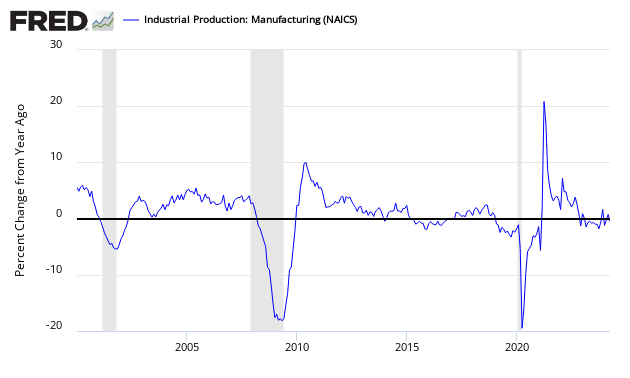January 2020 Kansas City Fed Manufacturing Remains In Contraction
Of the three regional manufacturing surveys released for January, two were in expansion and one was in contraction.

Analyst Opinion of Kansas City Fed Manufacturing
Kansas City Fed manufacturing has been one of the more stable districts and their index even though below the range seen in the last 12 months. Note that the key internals were in contraction. This should be considered similar to last month.
Market expectations from Econoday were ---- to ---- (consensus ---). The reported value was -1. Any value below zero is in contraction.
(Click on image to enlarge)
z kansas_man.PNG
Tenth District manufacturing activity was nearly flat in January while expectations for future activity expanded (Chart 1). The month-over-month prices for raw materials increased, while prices for finished products declined from a month ago. District firms continued to expect higher prices in the next 6 months.
The month-over-month composite index was -1 in January, slightly higher than -5 in December and -2 in November (Table 1). The composite index is an average of the production, new orders, employment, supplier delivery time, and raw materials inventory indexes. The slight decrease in district manufacturing activity was driven by declines in: nonmetallic mineral products, primary metal, fabricated metal products, computer and electronic products, beverage and tobacco products, and printing manufacturing, while several other industries improved. Most month-over-month indexes remained slightly negative in January, and inventories continued to decline. However, the month-over-month employment index rose back into positive territory for the first time in over six months and the supplier delivery time index was also slightly positive. Year-over-year factory indexes dropped further in January, and the composite decreased from -4 to -7. On the other hand, the future composite index grew from 9 to 14 in January.
"Regional factory activity was down only slightly in January, and firms reported a modest increase in employment," said Wilkerson. "Contacts reported slightly less difficulty finding workers than six months ago, but still over 60 percent of firms were experiencing labor shortages."
Summary of all Federal Reserve Districts Manufacturing:
Richmond Fed (hyperlink to reports):
(Click on image to enlarge)
Dallas Fed (hyperlink to reports):
(Click on image to enlarge)
Philly Fed (hyperlink to reports):
(Click on image to enlarge)
New York Fed (hyperlink to reports):
(Click on image to enlarge)
Federal Reserve Industrial Production - Actual Data (hyperlink to report):
(Click on image to enlarge)

Holding this and other survey's Econintersect follows accountable for their predictions, the following graph compares the hard data from Industrial Products manufacturing subindex (dark blue bar) and US Census manufacturing shipments (red bar) to the Kansas City Fed survey (light green bar).
Comparing Surveys to Hard Data:
(Click on image to enlarge)

In the above graphic, hard data is the long bars, and surveys are the short bars. The arrows on the left side are the key to growth or contraction.
Disclaimer: No content is to be construed as investment advise and all content is provided for informational purposes only.The reader is solely responsible for determining whether any investment, ...
more







